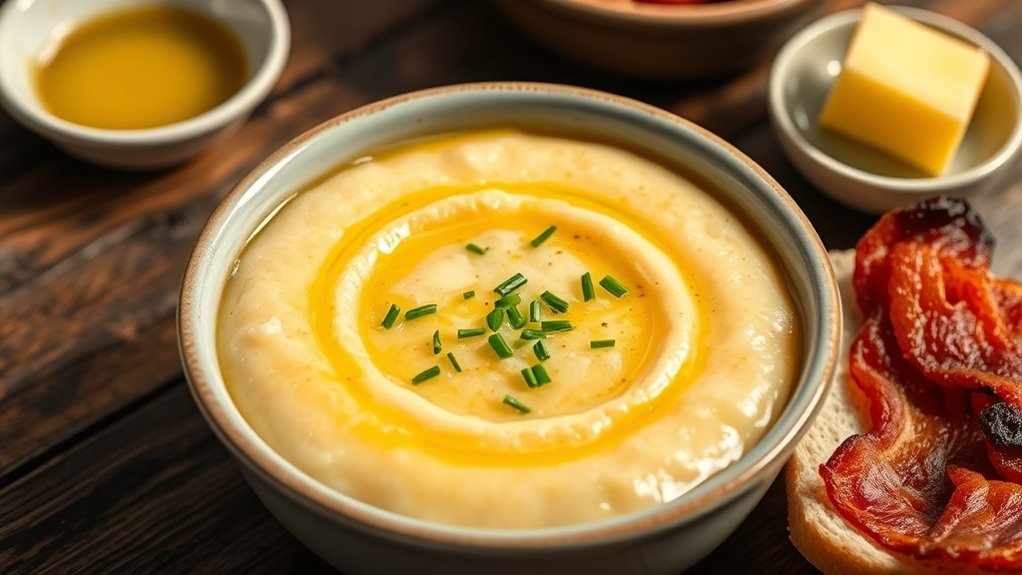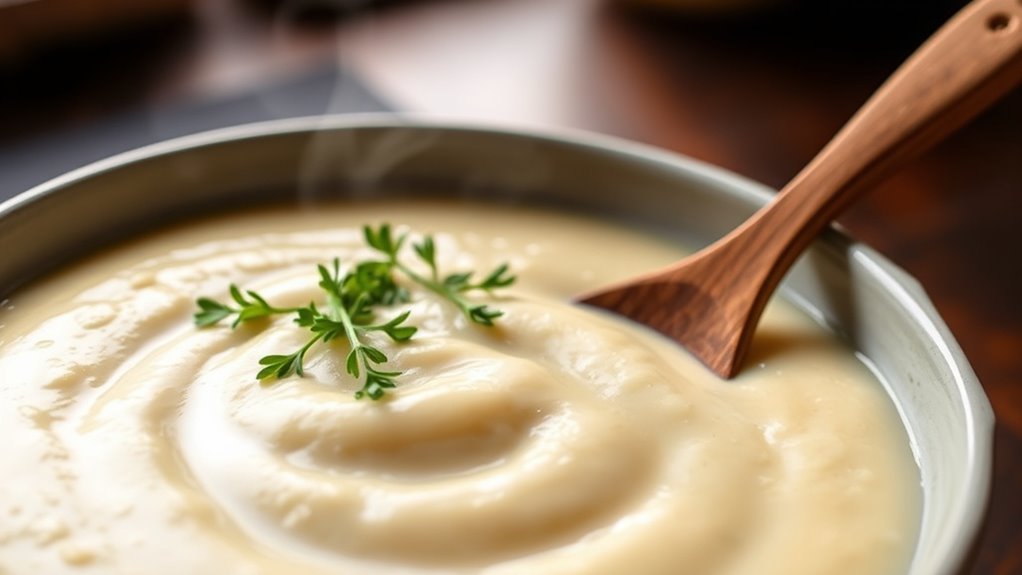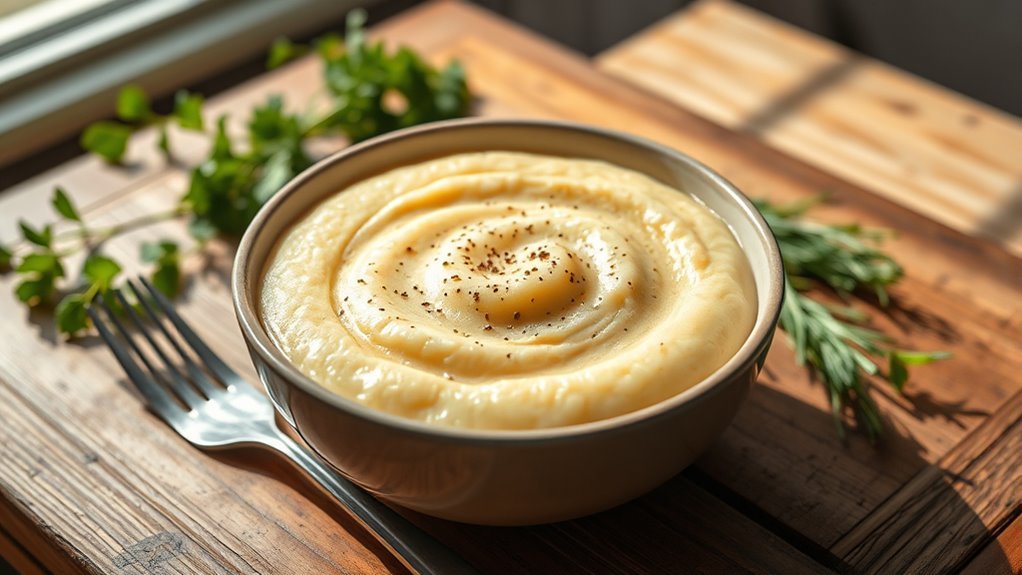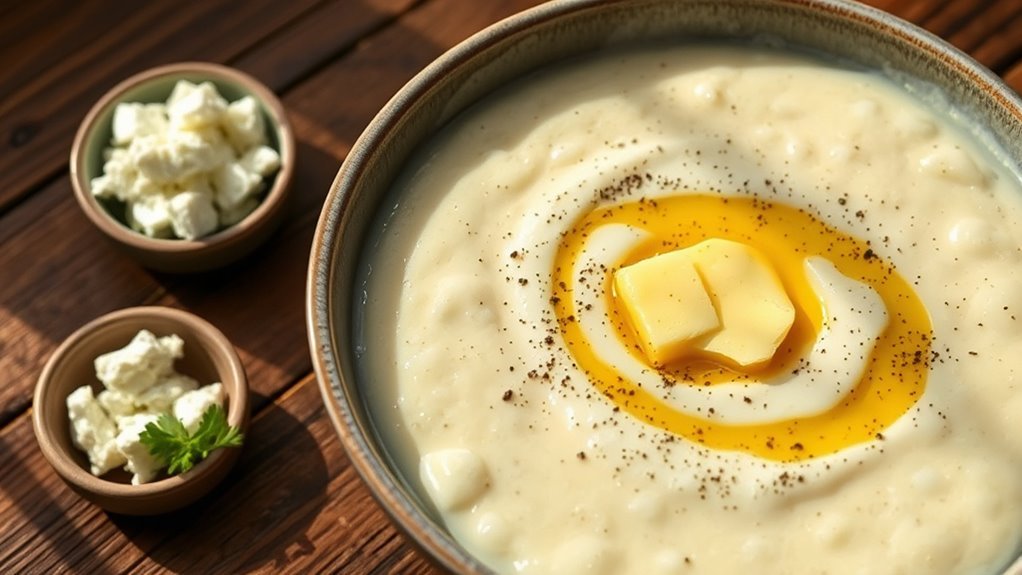Grits aren’t typically keto-friendly due to their high carbohydrate content, often exceeding your daily carb limits for ketosis. A standard serving has about 30 grams of carbs, which can spike blood sugar levels. While traditional grits can be delicious, instant versions may have even lower nutrients and additives. Fortunately, there are low-carb alternatives like cauliflower rice or zucchini noodles that can satisfy your cravings. To learn how to enjoy Southern cuisine on keto, explore some tasty substitutes.
Understanding the Nutritional Profile of Grits

Grits, a staple dish in Southern cuisine, are made from ground corn and are often enjoyed as a breakfast item or side dish. They offer significant nutritional benefits, including essential vitamins and minerals such as B vitamins, iron, and magnesium. Grits are also a good source of carbohydrates, providing energy for your day. When it comes to cooking methods, you can prepare grits in various ways—boiling, baking, or even slow-cooking. Each method brings out different textures and flavors, allowing you to customize your dish. Whether you prefer creamy, cheesy grits or a firmer texture, you can enjoy this versatile food while reaping its health benefits. Understanding grits’ nutritional profile helps you make informed choices in your diet.
Carb Content of Grits Compared to Keto Guidelines

When considering grits on a keto diet, it’s essential to examine their carb content in relation to your daily limits. Traditional grits can contain a significant amount of carbohydrates, often exceeding what’s typically allowed on a keto plan. Fortunately, there are alternatives that can help you stay within your carb goals while still enjoying satisfying meals.
Grits Nutritional Overview
For those following a ketogenic diet, understanding the nutritional profile of various foods is essential. Grits, made from ground corn, have a rich history in Southern cuisine and offer some grits benefits, such as being a source of vitamins and minerals. However, their carb content is significant; a typical serving can contain about 30 grams of carbs. This amount can easily exceed the daily carb limits many keto dieters endeavor to maintain. While grits can provide energy and fiber, they may not align with your keto goals if you’re aiming for a low-carb lifestyle. Knowing these nutritional aspects can help you make informed choices about including or excluding grits from your diet.
Keto Carb Limits
Understanding the carb limits of a ketogenic diet is essential for making informed food choices. Typically, keto dieters aim for about 20 to 50 grams of net carbs per day. When it comes to grits, they’re high in carbohydrates—around 24 grams per half-cup serving. This makes them challenging to fit into your keto meal planning without exceeding your daily carb limit. If you’re serious about carb counting, consuming grits could derail your ketogenic goals. Instead, consider how other lower-carb alternatives can provide you with similar textures or flavors without the carbohydrate load. By being mindful of your choices, you can maintain the freedom to enjoy meals while adhering to your keto lifestyle effectively.
Alternatives to Grits
Although grits are a popular dish, their high carbohydrate content makes them less than ideal for a ketogenic diet. If you’re looking for keto substitutions, consider using cauliflower rice or zucchini noodles as grain alternatives. Cauliflower rice is low in carbs and can mimic the texture of grits when prepared correctly. Another option is shirataki noodles, made from konjac yam, which are almost zero-calorie and carb-free. For a creamier texture, you might try mashed avocado or a savory coconut cream base. These alternatives not only fit within keto guidelines but also provide versatility in your meals. Embracing these substitutions allows you to enjoy satisfying dishes without straying from your low-carb lifestyle.
The Impact of Grits on Blood Sugar Levels

When considering grits, it’s important to look at their glycemic index, which measures how quickly foods raise blood sugar levels. Grits typically have a moderate glycemic index, meaning they can cause a noticeable spike in blood sugar shortly after consumption. Understanding this response can help you make informed choices about including grits in your diet.
Glycemic Index of Grits
The glycemic index (GI) of grits can greatly influence how they affect your blood sugar levels. Generally, grits have a higher GI, meaning they can lead to a quick glycemic response. This spike might not be ideal if you’re trying to maintain stable blood sugar levels. If you’re looking for grits alternatives, consider options like cauliflower rice or zucchini noodles, which typically have a lower GI and can help keep your blood sugar in check. By choosing lower-GI foods, you can enjoy more freedom in your diet while managing your health. Remember, it’s important to balance your meals and monitor how different foods affect your body, especially if you’re following a keto lifestyle or aiming for better glycemic control.
Blood Sugar Response
Grits can considerably impact your blood sugar levels due to their high glycemic index. When consumed, they can cause a rapid spike in blood sugar, which isn’t ideal for those undergoing keto adaptation. This spike can lead to energy crashes and cravings, making it harder to maintain a low-carb lifestyle. If you’re aiming for stable blood sugar levels, it’s vital to contemplate alternatives that won’t disrupt your keto goals. Foods lower on the glycemic index can help you achieve better control over your blood sugar and support your body’s change into ketosis. Remember, choosing the right foods is key to enjoying the freedom of a balanced lifestyle while managing your blood sugar effectively.
Traditional vs. Instant Grits: Which Is Better?
Which type of grits is better for your diet: traditional or instant? Traditional preparation involves slow-cooking stone-ground corn, which preserves more nutrients and fiber. This method might take longer, but it often results in a richer flavor and better texture. On the other hand, instant grits offer unmatched convenience, allowing you to whip up a meal in mere minutes. However, they often contain fewer nutrients and additives that can spike your blood sugar. If you’re looking for a healthier option that aligns with your dietary goals, traditional grits could be the way to go. Yet, if life’s hustle demands quick meals, instant grits might still fit your needs—though be mindful of their nutritional downsides. Choose wisely!
Exploring Low-Carb Alternatives to Grits
If you’re looking for low-carb alternatives to grits, there are several tasty options to contemplate. Cauliflower rice can mimic the texture of grits while keeping your carb count low, and chia seed pudding offers a nutritious, creamy alternative. You might also want to try a zucchini grits recipe, which can provide a similar comfort food experience without the carbs.
Cauliflower Rice Option
While traditional grits can be high in carbohydrates, cauliflower rice emerges as a compelling low-carb alternative that fits seamlessly into a keto diet. Packed with cauliflower benefits, this versatile option not only satisfies your cravings but also keeps your carb intake in check. You can easily incorporate cauliflower rice into various keto recipes.
Here’s a quick comparison:
| Nutrient | Traditional Grits | Cauliflower Rice |
|---|---|---|
| Carbohydrates (g) | 24 | 5 |
| Calories | 130 | 25 |
| Fiber (g) | 1.0 | 2.0 |
With its low-calorie count and high fiber content, cauliflower rice can be your go-to substitute for grits, allowing you to enjoy your meals without compromising your keto lifestyle.
Chia Seed Pudding
Chia seed pudding offers a delicious and nutritious low-carb alternative to traditional grits, making it an excellent choice for those on a keto diet. Packed with fiber, omega-3 fatty acids, and protein, chia seeds provide numerous health benefits. These tiny powerhouses can help you feel full longer, stabilize blood sugar levels, and promote digestive health. To create a keto-friendly treat, mix chia seeds with unsweetened almond milk and a keto-friendly sweetener like erythritol or stevia. Let the mixture sit until it thickens, then add your favorite low-carb toppings, such as berries or nuts. By choosing chia seed pudding, you can enjoy a satisfying and versatile dish that aligns perfectly with your low-carb lifestyle while still indulging your taste buds.
Zucchini Grits Recipe
When you’re looking for a low-carb alternative to traditional grits, zucchini grits can be a game changer. To prepare zucchini grits, start by grating two medium zucchinis and squeezing out excess moisture. Cook the grated zucchini in a non-stick skillet over medium heat for about five minutes until tender. For the perfect grits seasoning, mix in a pinch of salt, pepper, and a tablespoon of butter or olive oil for richness. You can also add cheese or nutritional yeast for extra flavor. Enjoy your zucchini grits as a base for dishes like shrimp and grits or serve them alongside eggs. This creative twist allows you to indulge without sacrificing your low-carb lifestyle.
Creative Keto-Friendly Grits Recipes
If you’re looking to enjoy the comforting texture of grits while sticking to your keto diet, there are plenty of creative recipes to explore. One popular option is using cauliflower as a grits alternative. Simply steam and blend cauliflower with cream, butter, and cheese to achieve a creamy consistency. Another great choice is using almond flour or coconut flour mixed with water, heating it until thickened for a delightful base. For a savory twist, consider adding sautéed spinach or cheese to enhance flavor. You can also experiment with spices like garlic or paprika. These keto-friendly recipes not only satisfy your cravings but also keep your carb intake low, allowing you to enjoy grits without guilt!
How to Incorporate Grits Into a Keto Diet Mindfully
Enjoying keto-friendly grits can be a delicious addition to your meal plan, but it’s important to incorporate them mindfully to stay within your carb limits. Start by measuring your portion sizes to avoid exceeding your daily carb intake. Consider using grits substitutes like cauliflower rice or zucchini noodles, which can provide a similar texture with fewer carbs. For effective keto meal prep, try preparing a small batch of grits and complementing them with high-fat toppings, like butter or cheese, to enhance flavor without adding extra carbs. Always keep an eye on your overall macronutrient balance, and don’t forget to track how these grits fit into your personal keto goals. Enjoy the freedom of creativity while staying mindful!
The Role of Fiber in Grits and Keto
Although grits are often viewed as a high-carb food, their fiber content can play an essential role in a keto diet. The fiber types found in grits, particularly soluble fiber, can help regulate your digestion and may lower cholesterol levels. This can enhance your overall health, making your keto journey more sustainable. While grits do contain carbs, focusing on their fiber can provide keto benefits by promoting satiety and stabilizing blood sugar levels. You can enjoy grits in moderation, balancing them with low-carb foods to maintain ketosis. By understanding the role of fiber, you’re empowered to make informed choices that fit your lifestyle while still enjoying the flavors you love.
Common Misconceptions About Grits and Ketosis
While many people assume that grits are strictly off-limits for those on a keto diet, this belief often stems from misunderstandings about their nutritional profile. It’s true that traditional grits are high in carbohydrates, but not all grits are created equal. Some options, like cauliflower grits or those made from alternative flours, can fit into your dietary choices without derailing your ketosis. Misleading information often clouds the conversation around grits, leading many to dismiss them entirely. Understanding the different types of grits allows you to make informed decisions that align with your goals. Embracing flexibility in your diet can empower you to enjoy flavorful dishes while maintaining your desired lifestyle, breaking free from restrictive notions about food.
Tips for Staying in Ketosis While Enjoying Southern Cuisine
When you’re craving Southern cuisine, it’s possible to indulge without sacrificing your keto goals. Here are some tips to help you enjoy comfort food while staying in ketosis:
- Keto adaptations: Substitute traditional grits with cauliflower mash or zucchini noodles. These alternatives maintain texture variations while cutting carbs.
- Flavorful toppings: Use Southern spices like paprika and cayenne to enhance your dishes without added carbs. Consider toppings like cheese, avocado, or sour cream for extra flavor.
- Cooking methods: Opt for grilling, baking, or sautéing instead of frying. These methods preserve the taste while keeping meals healthy.


